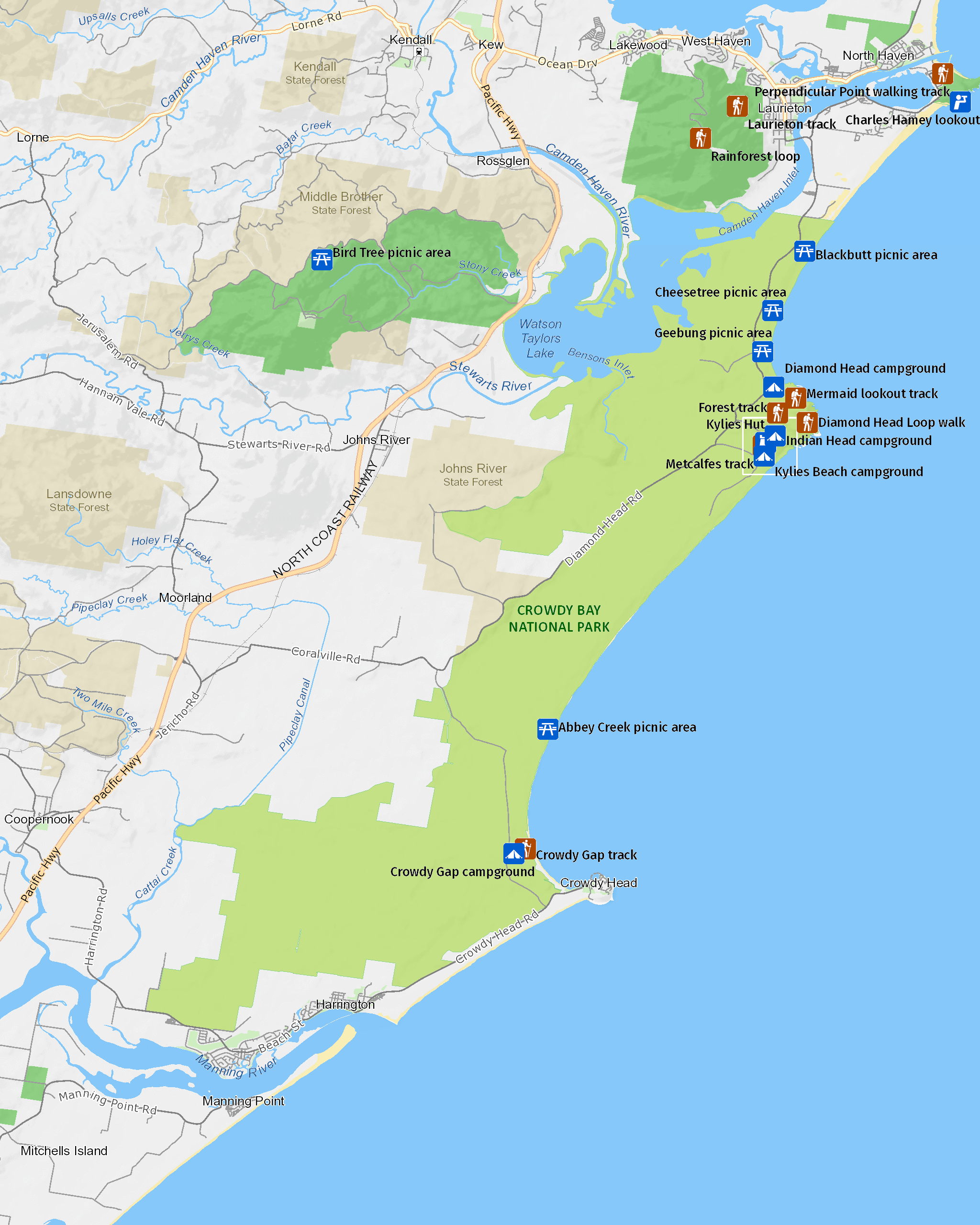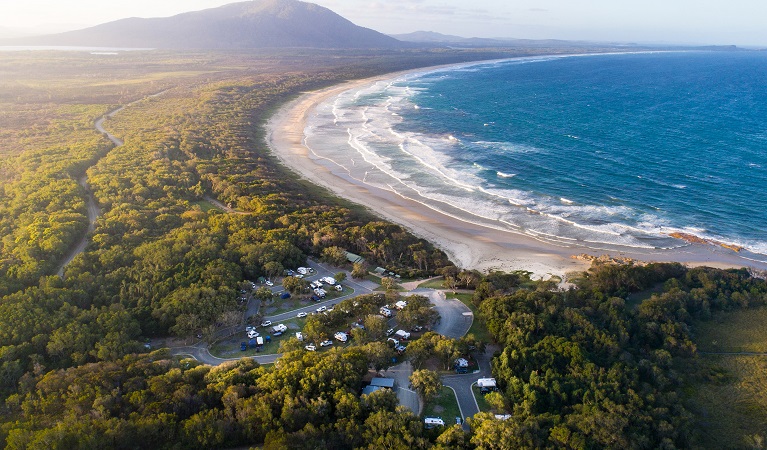Crowdy Bay National Park
Overview
Crowdy Bay National Park, near Port Macquarie is a great coastal getaway. Offering beach camping, picnic areas, fishing spots and walking tracks, there is plenty to see and do.
Read more about Crowdy Bay National Park
Protecting a pristine sweep of coastline near Port Macquarie and Taree, Crowdy Bay National Park is one of the most glorious coastal parks of NSW. It offers jaw-dropping ocean and mountain views, an abundance of wildlife and, despite its name, crowd-free beaches.
The best part? That’s for you to decide, but if you dream of camping on ocean shores, strolling barefoot in the dunes, roving a rainforest, seeing a whale blow or even discovering a hidden writer’s retreat, then this is the place for you.
Aboriginal people have known its bountiful wonders for over 6000 years, Captain Cook glimpsed its glittering beauty in 1770 and it is all still here for you to enjoy.
Go for a day or plan to stay, but be aware that this is a place so enthralling that time slips away.
Local alerts
For the latest updates on fires, closures and other alerts in this area, see https://www.nationalparks.nsw.gov.au/visit-a-park/parks/crowdy-bay-national-park/local-alerts
Map

Map

Map legend

Contact
- in the North Coast region
Crowdy Bay National Park is always open but may have to close at times due to poor weather or fire danger.
-
Park entry fees:
$8 per vehicle per day.
Buy annual pass. -
-
Port Macquarie office
02 6588 5555 for general enquiries only, no bookings.
Contact hours: Monday to Friday, 9am to 4.30pm. - 22 Blackbutt Road, Port Macquarie NSW 2444
-
Email: npws.hastingsmacleay@environment.nsw.gov.au
-
Port Macquarie office
Visitor info
All the practical information you need to know about Crowdy Bay National Park.
Maps and downloads
Nearby towns
Laurieton (4 km)
Located at the base of North Brother Mountain in Dooragan National Park, Laurieton is one of the villages that make up the Camden Haven area on the North Coast of NSW. Laurieton is 30km south of Port Macquarie and offers an idyllic holiday spot for families, nature-lovers and anyone who enjoys a holiday by the beach.
Taree (41 km)
Taree is a major mid North Coast city, ringed by superb beaches. It's situated on the Manning River and set against rolling hills.
Port Macquarie (45 km)
Vibrant Port Macquarie is surrounded by beautiful waterways - the Hastings River, canals, creeks, bays and the Pacific Ocean. The city also has a five-star collection of golden-sand beaches stretching from Port Macquarie Beach to Town Beach and north along the 16-km swathe of North Beach.
Learn more
Crowdy Bay National Park is a special place. Here are just some of the reasons why:
Writers' retreat

During World War II, the Australian author Kylie Tennant moved to Laurieton where she met the reclusive Ernie Metcalfe, a farmer who grazed cattle on Diamond Head. Ernie built Kylie a timber slab hut to use as a writer's retreat. In return, Kylie portrayed Metcalfe and Crowdy Bay in the book The Man on the Headland. Kylie Tennant donated the hut and the surrounding land to Crowdy Bay National Park in 1976. If you're walking along Metcalfe walking track, stop to have a look inside Kylie's hut.
- Kylies Hut Visit Kylies Hut along Metcalfes walking track in Crowdy Bay National Park, near Port Macquarie. The historic hut was used as a writer’s retreat by award-winning Australian novelist Kylie Tennant.
Postcard perfect

This spectacular environment is truly something to write home about. If you can't find the words, try these - panoramic, breathtaking, even gobsmacking. Then again, you'll probably be too busy exploring the tracks, gazing agape at the huge rock arches, communing with wildlife or throwing a line to write lines on a postcard.
- Crowdy Gap walking track The short and sweet Crowdy Gap walking track in Crowdy Bay National Park, near Taree, offers a stroll through rainforest with scenic views and the chance to see koalas.
- Diamond Head Loop walk Diamond Head loop walk offers scenic coastal views across Crowdy Bay National Park. Expect beaches, lookouts, and glinting rock faces, giving Diamond Head its name.
Past present

The Birpai People have climbed the headlands, swum in the rivers, crossed the sand dunes and walked the beaches of Crowdy Bay National Park for thousands of years. The sea and forest areas were a rich food source for the Birpai People, providing fish, shellfish, wallabies and berries. The park protects a number of Aboriginal sites, like shell middens and campsites, the oldest of which are about 6,000 years old. The park continues to be an important place for local Aboriginal people today.
Gifts of nature

The views may grab the headlines, but within the park are more secretive delights that change with the seasons. These include rolling dunes that spring to life with wildflowers and migratory birds that populate the lagoons. There are lots of great lookouts to spot whales from as they migrate along the coast in winter or watch ospreys and falcons circle in the skies. Not to mention, kangaroos, koalas and cockatoos galore. Christmas visitors will receive an extra gift, Crowdy Bay's famous festive season blooms of Christmas bells.
- Mermaid lookout track Mermaid lookout track takes you on a tour of Crowdy Bay National Park's secret surprises. Secluded coves, sweeping beaches and mountain views await you on this short hike.
- Metcalfes walking track Get up close with nature on Metcalfes walking track, which links Indian Head and Kylies Beach in Crowdy Bay National Park. It's a family friendly hike and the kids might even spot a koala.
Plants and animals protected in this park
Animals
-

White-bellied sea eagle (Haliaeetus leucogaster)
White-bellied sea eagles can be easily identified by their white tail and dark grey wings. These raptors are often spotted cruising the coastal breezes throughout Australia, and make for some scenic bird watching. Powerful Australian birds of prey, they are known to mate for life, and return each year to the same nest to breed.
-

Brown-striped frog (Lymnastes peronii)
One of the most common frogs found in Australia, the ground-dwelling brown-striped frog lives in ponds, dams and swamps along the east coast. Also known as the striped marsh frog, this amphibian grows to 6.5cm across and has a distinctive ‘tok’ call that can be heard all year round.
-

Lace monitor (Varanus varius)
One of Australia’s largest lizards, the carnivorous tree-dwelling lace monitor, or tree goanna, can grow to 2m in length and is found in forests and coastal tablelands across eastern Australia. These Australian animals are typically dark blue in colour with whitish spots or blotches.
Plants
-

Black sheoak (Allocasuarina littoralis)
The black sheoak is one of a number of casuarina species found across the east coast of Australia and nearby tablelands. Growing to a height of 5-15m, these hardy Australian native plants can survive in poor or sandy soils. The barrel-shaped cone of the black sheoak grows to 10-30mm long.
-

Grass tree (Xanthorrea spp.)
An iconic part of the Australian landscape, the grass tree is widespread across eastern NSW. These Australian native plants have a thick fire-blackened trunk and long spiked leaves. They are found in heath and open forests across eastern NSW. The grass tree grows 1-5m in height and produces striking white-flowered spikes which grow up to 1m long.
Environments in this park
Education resources (1)
What we're doing
Crowdy Bay National Park has management strategies in place to protect and conserve the values of this park. View the detailed park and fire management documents. Here is just some of the work we’re doing to conserve these values:
Preserving biodiversity
Endangered habitats are found in Crowdy Bay National Park. NPWS is committed to the survival of endangered species and the ecosystems on which they depend, and works to educate the public on sustainable national park visitation wherever possible. Interpretive information on the topic is regularly maintained within this park. Programs to rehabilitate damaged parkland is also ongoing.
Managing weeds, pest animals and other threats
Pests and weeds have a significant impact to the ecosystems within Crowdy Bay National Park. Risk assessments for new and emerging weeds are carried out as an ongoing initiative within the park. Pest management of weeds such as bitou bush and lantana, and vertebrate pests like foxes is a priority and an important part of the work NPWS does to protect the integrity of biodiversity which exists within Crowdy Bay National Park.
Developing visitor facilities and experiences
Crowdy Bay National Park is committed to keeping its visitors safe and informed, and this extends to issues of park access. Maintenance of national park infrastructure, including roads and access systems, is ongoing in this park, with relevant upgrades designed to further protect beaches and other natural assets.
Conserving our Aboriginal culture
Aboriginal culture is of great value to NPWS and the wider community, and the conditions of Crowdy Bay National Park’s significant Aboriginal sites and assets are monitored and conserved. In doing this, NPWS liaises with local Aboriginal communities wherever possible, and NPWS consideration of new interpretation projects is ongoing.
Managing fire
NSW is one of the most bushfire prone areas in the world as a result of our climate, weather systems, vegetation and the rugged terrain. NPWS is committed to maintaining natural and cultural heritage values and minimising the likelihood and impact of bushfires via a strategic program of fire research, fire planning, hazard reduction, highly trained rapid response firefighting crews and community alerts.

